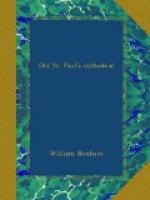Close by John of Gaunt, between the pillars of the 6th bay of the Choir, was the tomb of WILLIAM HERBERT (1501-1569), first Earl of Pembroke of the second creation, a harum-scarum youth, who settled down into a clever politician, and was high in favour with Henry VIII., who made him an executor of his will, and nominated him one of the Council of twelve for Edward VI. He went through the reign of Mary not without suspicion of disloyalty, but was allowed to hold his place at Court, and in the reign of Queen Elizabeth he was accused of favouring the Queen of Scots, though here also he overcame the suspicions, and did not lose his place. He married Anne, the sister of Queen Catherine Parr, and they were both buried in St. Paul’s.
JOHN OF CHISHULL, who filled the see from 1274-1280, and was Edward III.’s Chancellor, held a great number of valuable posts together. This may have produced the mental incapacity into which he fell. Archbishop Peckham had to appoint a commission to manage the diocese. He was buried against the wall of the North Aisle, not far from John of Gaunt.
ROGER NIGER, bishop from 1228 to 1241, was buried under the fifth bay of the Choir, between it and the North Aisle. There were three inscriptions on his tomb, the first on the aisle side:
“Ecclesiae quondam Praesul praesentis,
in anno
M bis C quater X jacet hic Rogerus humatus:
Hujus erat manibus Domino locus iste dicatus:
Christe, suis precibus veniam des; tolle
reatus.”
Then we have a short biography in laudatory terms, and below that a record which one may translate as it stands: “It came to pass while this Bishop Roger stood mitred [infulatus] before the high altar, ready to begin the Divine mysteries, there came on such a dense cloud that men could scarcely discern one another; and presently a fearful clap of thunder followed, and such a blaze of lightning and intolerable smell, that all who stood by fled hastily, expecting nothing less than death. The Bishop and one deacon only bravely remained, and when the air was at length purified the Bishop completed the service.” We shall have more about this storm hereafter.
SIR JOHN MASON (1503-1566), the son of a cowherd at Abingdon, and afterwards a great benefactor to that town. His mother was a sister to the Abbot of Abingdon, and through this relationship he was educated at Oxford, became a Fellow of All Souls’, took orders, and, in consequence of the skill which he displayed in diplomacy and international law, received rich Church preferments, among them the Deanery of Winchester. At the accession of Queen Mary he had to relinquish this, but as he had been faithful to her, she showed him much favour, and gave him some secular offices. On the accession of Elizabeth, he returned to his Deanery, and was all his life one of the most trusted of the Queen’s councillors, especially in foreign matters.
DR. WILLIAM AUBREY was appointed Vicar-General of Canterbury by Archbishop Grindal, and was esteemed a great lawyer in his time. He was the grandfather of the famous antiquary (d. 1595).




